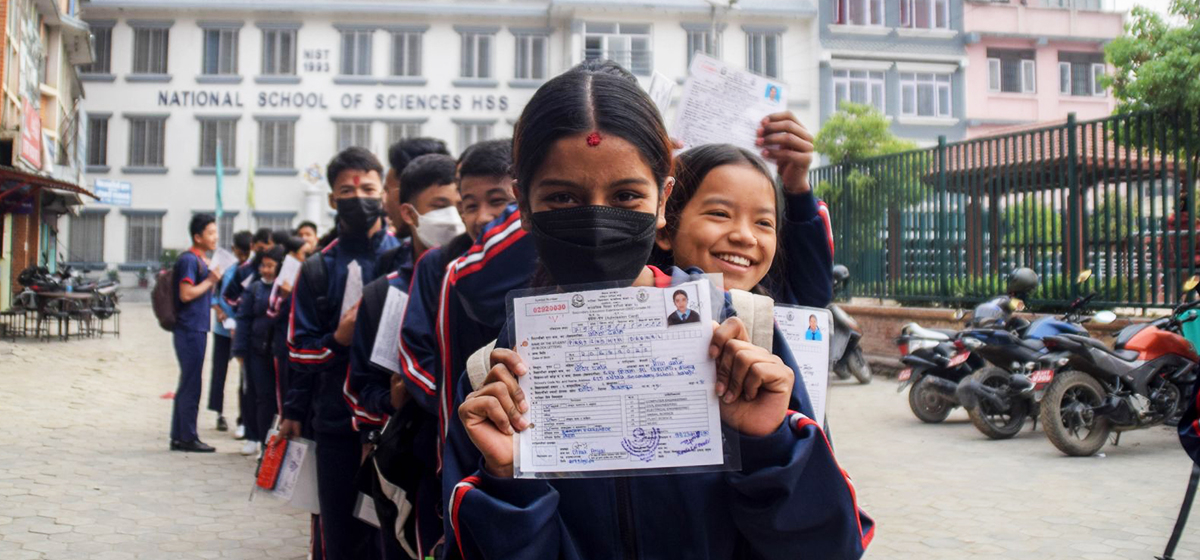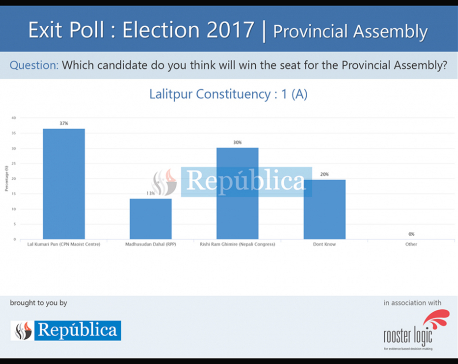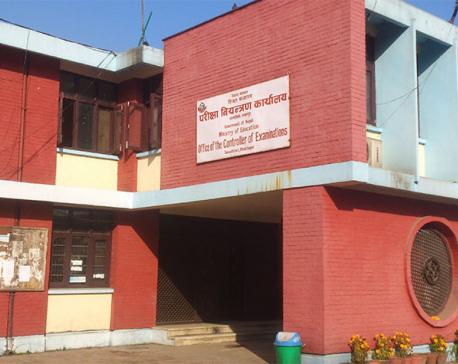
OR
Opinion
Did the SEE result genuinely improve this year?
Published On: August 13, 2023 09:05 AM NPT By: Amar Bahadur Sherma

More from Author
Last month, the National Examinations Board (NEB), Sanothimi, Bhaktapur, published the result of the Secondary Education Examinations (SEE) of the year 2079/80 BS, which once was popularly known as the “Iron Gate” due to the difficulty level of the questions, the staggering number of passes, and the prestige associated with the percentage. On the contrary, recently there has been less air of exultation between most students, parents, academicians and stakeholders. In 2020 and 2021, the board issued the grade sheets to students based on the internal evaluation of the respective schools owing to the Covid-19 pandemic. Since then, SEE results have been improving, at least on paper, not in real picture. And, NEB officials have taken pride in the result.
Of 485,229 students who sat for the SEE last April, 22,475 obtained a GPA of 3.6 to 4.0, which is almost three percent more than that of the previous year. Similarly, this year, 55,069 students received a GPA of 3.0 to 3.6, which is nearly nine percent more in comparison to that of the previous year’s result. The most remarkable thing is the number of students scoring average marks has remained almost the same this year too, compared to last year. Last year, a total of 18.31 percent of students had acquired a GPA of 2.4 to 2.8. The number is almost equal at 18.42 percent this year.
Comparatively, this year’s result has witnessed a meager increase. In the previous two years, schools had an opportunity to give marks based on their continuous assessments. Moreover, due to the lack of online resources and accessibility in most of our country, schools had to consider the potential their students possessed and reward them with better grades. Yes, I cannot deny the fact that some schools rewarded many of their students with a GPA of 4 unnecessarily.
This is apparently because most of these students missed a significant portion of their content/syllabus two years in a row. The loss was naturally thought to have an adverse effect on the SEE result. Contrarily, students nowadays get hooked on gadgets rather than study materials. Instead of rejoicing at the fugacious outcome, I, as an educator, feel an overwhelming urge to bring to the notice of the concerned some thought-provoking questions: Can SEE grades reflect the overall potential of a student? Has every GPA 3.6 to 4.0 achiever excelled at grades 11-12 too? Aren’t we striving to improve on pass percentage rather than identifying and nurturing students’ innate competence to placate students and their parents? Were the examinations administered under stringent conditions last year? Were last year’s question papers easier? Did SEE examiners mark exam papers scientifically, fairly, and diligently? Were the teachers gifted magic wands by God to change everything overnight? The conduct of the SEE examination itself is questionable.
Upholding the tradition
No sooner had the NEB published the SEE result than Facebook walls were filled with congratulatory posts, encapsulating GPA points, which was enough for us to analyze and infer that some students obtained better GPA points than expected. As always, some parents and schools lost their patience and hurried to declare SEE valedictorians themselves, which sounds ridiculous. Furthermore, GPA 4.0 holders cannot be ranked in order of their marks or percentage. It’s condemnable to claim the SEE board valedictorian status to gain fake publicity. It has been several years since the government phased out the percentage system and “board topper status” to curb unhealthy competition among educational institutions. The idea of percentage and marks preference is still ingrained in the Nepali people’s minds. It’s a bitter truth that a student’s skills, knowledge and discipline are usually overshadowed by GPA points. What still beats me is that students’ first priority is science and they tend to believe high-profile careers have been reserved only in these fields—medicine, technology, law, computer science, etc. Can’t average students who obtain lower grades than a GPA of 3.6 aspire to be successful in their lives?
The SLC result has always come under attack because it’s reliant on summative assessment. A three-hour examination cannot reflect student learning and his/her real capabilities. Since this exam determines their further education and career, several students have fallen victim to it. Some progressive schools in Nepal are laying equal emphasis on both academic and co-curricular domains, keeping in mind the need for holistic development to be a global citizen. The publicity of GPA holders on schools’ ends and the efforts of the government to improve quantitative outcomes rather than the quality of education to attract more foreign donors can easily be perceived as a continuation of the traditional result-oriented mindset and the subtle acquisition of the board valedictorian status, which, indeed, is an indication that we aren’t ready to get rid of the grade obsession and mentality.
A web of problems
Our education system is also heavily influenced by the Indian education system. To some extent, GPA gives a tentative idea about a child’s potential, but it doesn’t reflect the overall talent. Curriculum designers aren’t the implementers; exam boards aren’t student counselors; schools aren’t manufacturers of students with the same caliber, and teachers aren’t magicians. Parents’ unreasonable demand for a GPA of 3.6 to 4.0 isn’t more important than the positive attitude their children develop, the good habits they form, and the leadership skills they exhibit. In addition, linking prestige with lucrative professionals like doctors, engineers, scientists, pilots, etc. sounds absurd in this era. On top of this, the core of the problem lies in the minimum GPA criterion to receive a scholarship or grant, do a university course, or get better jobs. Whatever a student achieves or learns as a student is overshadowed by GPA or percentage obtained in board exams. I strongly believe that GPA or percentage criteria should be deemed inappropriate in every sphere of life but used as minor prerequisites. When a GPA 3.6+ holder fails an entrance test, who is to be blamed? It isn’t surprising if teachers are criticized on a charge of a lack of professionalism, inefficiency, nepotism, poor quality of teaching, etc. Therefore, blaming teachers and schools only for such ridiculous SEE results every year isn’t fair. This is a kind of vicious circle where innocent teachers are caught too.
What’s the way-out?
Quality of teaching in cities and government schools is poles part. Setting the same question papers for two different groups of students who come from two different schooling backgrounds with two different mediums of instruction: English and Nepali isn’t justifiable. The government should rethink its educational policies. Parents should accept their child’s weaknesses and stop comparing their children with themselves or other GPA 3.6 to 4.0 achievers. We know our students are born with their unique talents. As parents, guardians, teachers, schools, and stakeholders, let us encourage students to pursue a career option that matches their interests, goals, and academic outcome. Let us stop overstressing a particular career field or stream. A balance between summative assessment and formative assessment must be struck for fair judgment of student learning. A Continuous Assessment System (CAS) must be implemented and regular monitoring must be done in both private and government schools. Most importantly, the government must impose hard-and-fast rules to govern the education system and take strict action against education mafias but support schools that come up with innovative ideas and contribute to the production of civilized, well-cultured, responsible and skilled manpower.
You May Like This

Exit poll results for Provincial Assembly of Lalitpur
Exit poll results for Provincial Assembly of Lalitpur ... Read More...

Local reps term starts 7 days after poll results
KATHMANDU, May 17 : The five-year term of the elected peoples' representatives of the local units will start seven days after... Read More...

SLC results today
KATHMANDU, June 16: The Office of the Controller of Examinations (OCE) is all set to publish SLC results on Thursday,... Read More...




Just In
- Sunkoshi-Marin Diversion Project’s tunnel construction nears completion, breakthrough scheduled for May 8
- Govt tightens security arrangement for Third Investment Summit 2024
- Pesticide residue found in vegetables in Nepalgunj
- Aam Janata Party and Samajwadi Jana Ekata Party merge
- 1,600 participants confirmed for Nepal Investment Summit
- Ilam-2 by-elections held peacefully, vote count likely to start tonight
- NEA schedules five-day power cut across Kathmandu Valley for underground cable installation
- Hundreds of passengers including foreign tourists in distress as poor visibility halts flights to and from PRIA







-1200x560-wm_20240427144118.jpg)





Leave A Comment